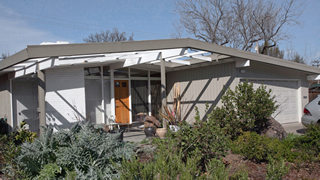Research Trumps Rumor
 |
|
|
 |
|
|
When one of America’s most admired men describes his boyhood home in glowing terms and, moreover, attributes some of his success to the home’s design, people tend to believe him.
So it’s no wonder that when author Walter Isaacson reported in his recent biography, Steve Jobs, that Jobs, the co-founder of Apple computer, grew up in an Eichler, the story would spread without anyone questioning its accuracy.
In fact, however, as first reported by CA-Modern in its weekly Featured Flash story e-mailed on February 15, 2012, the home in which Jobs lived from the late 1950s through most of the 1960s is not an Eichler.
The house, on Diablo Avenue in the Monta Loma neighborhood of Mountain View, was built by a competitor of Joe Eichler, Mackay Homes. It was likely built using designs by Anshen and Allen, Eichler’s first architectural firm, which worked for Mackay and another Peninsula builder of modern homes, Gavello, in the mid-1950s.
It’s interesting that, while Jobs did not live in an Eichler, Apple’s other co-founder, Steve Wozniak, did. That story broke in 2001 with a story and interview in the Eichler Network newsletter, the quarterly publication that later became CA-Modern.
That the home is a Mackay is obvious to people familiar with Eichler and Mackay homes, including several Peninsula realtors with specialties in the area. That the home is not an Eichler was also confirmed by Joe’s son, Ned Eichler, who worked for Eichler Homes as marketing manager beginning in 1954.
The low-gabled Jobs’ home uses certain different materials than an Eichler. Most Mackays were built using a standard foundation, not the slab-on-grade concrete used by Eichler; Eichlers featured in-slab radiant heating, Mackays forced-air.
Also, although CA-Modern was unable to find original Mackay sales brochures for the Monta Loma tract, the homes are identical to those pictured in sales material for nearby Mackay tracts, including Santa Clara’s Fairmede subdivision, built at the same time.
“I believe that Steve Jobs’ house was ‘The Crestmont,’ but with a reverse floor plan,” says Eric Boyenga, a realtor with Intero Real Estate services who knows Mackays well.
Why does it matter that Steve Jobs’ boyhood home wasn’t really an Eichler?
That the home was by Mackay doesn’t negate Jobs’ assertion that living in an open-plan, modern home stimulates an appreciation for simple, functional, elegant design.
“‘Eichler did a great job,’ Jobs said on one of our walks around the neighborhood,” Issacson wrote. “‘His houses were smart and cheap and good. They brought clean design and simple taste to lower-income people. They had awesome little features, like radiant heating in the floors. You put carpet on them, and we had nice toasty floors when we were kids.”
“Jobs said that his appreciation for Eichler homes instilled in him a passion for making nicely designed products for the mass market. ‘I love it when you can bring really good design and simple capability to something that doesn’t cost much,’ he said as he pointed out the clean elegance of the houses. ‘It was the original vision for Apple. That’s what we tried to do with the first Mac. That’s what we did with the iPod.’”
Wozniak, interestingly enough, denied in his 2001 interview that his boyhood Eichler home in Sunnyvale contributed to his being “more ambitious and adventurous,” though he did call it “my favorite home ever.”
“I loved the openness of a new home and a new neighborhood,” he said. “To this day, I believe that the way our Eichler looked, both when we moved in and in later years, influences what I primarily like in homes. I like bare walls with very few things hanging on them. To me that’s still beauty.”
That Jobs’ home was not an Eichler matters because facts matter and details matter.
Many people who live in homes that are like Eichlers oftentimes call them Eichlers. That’s why cognoscenti call them ‘likelers.’
Neither Eichler, after all, nor his architects, invented this general style of home, which is rooted in the modernism of the 1930s and 1940s.




